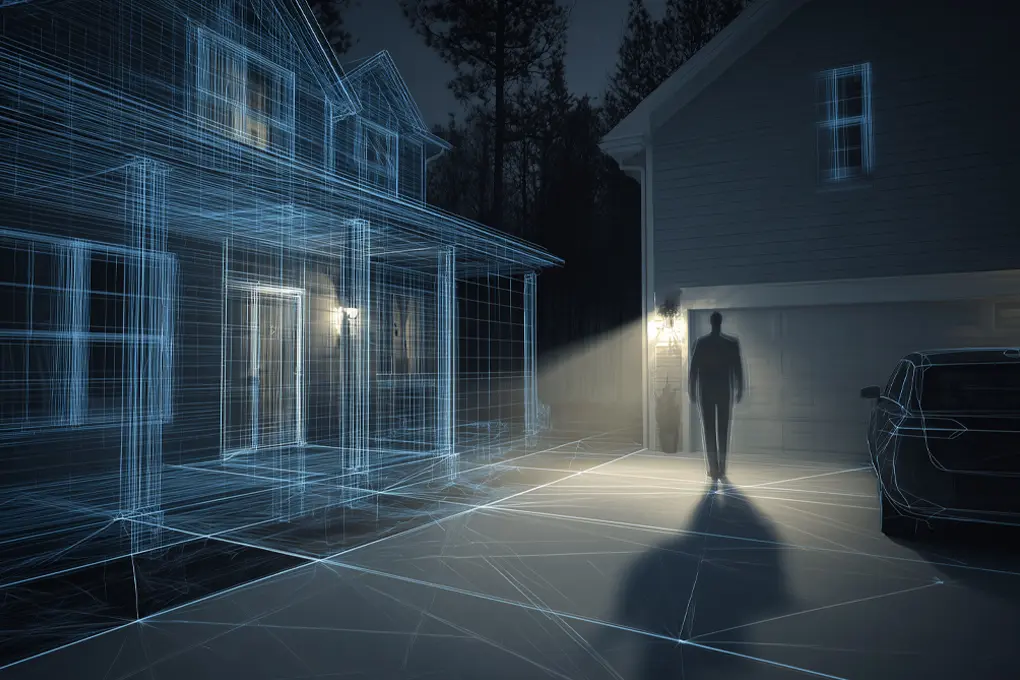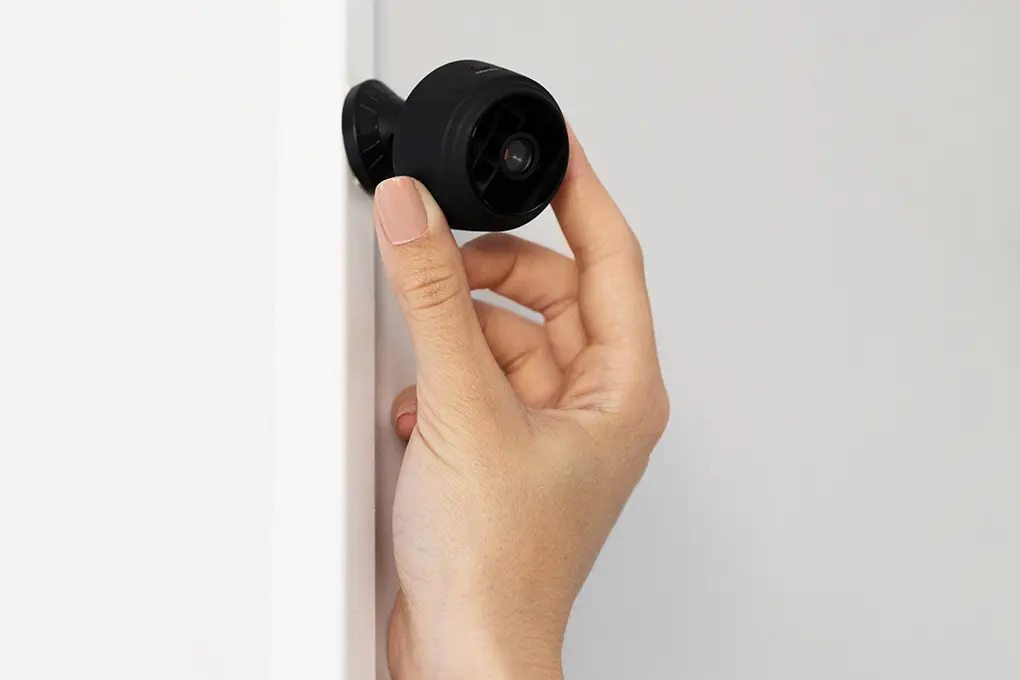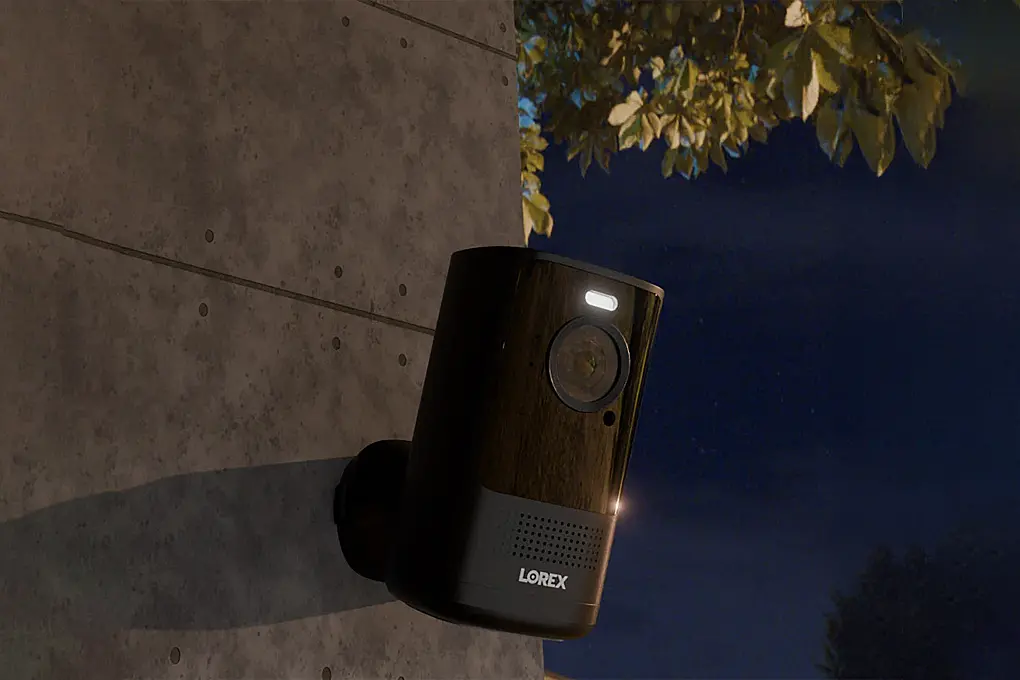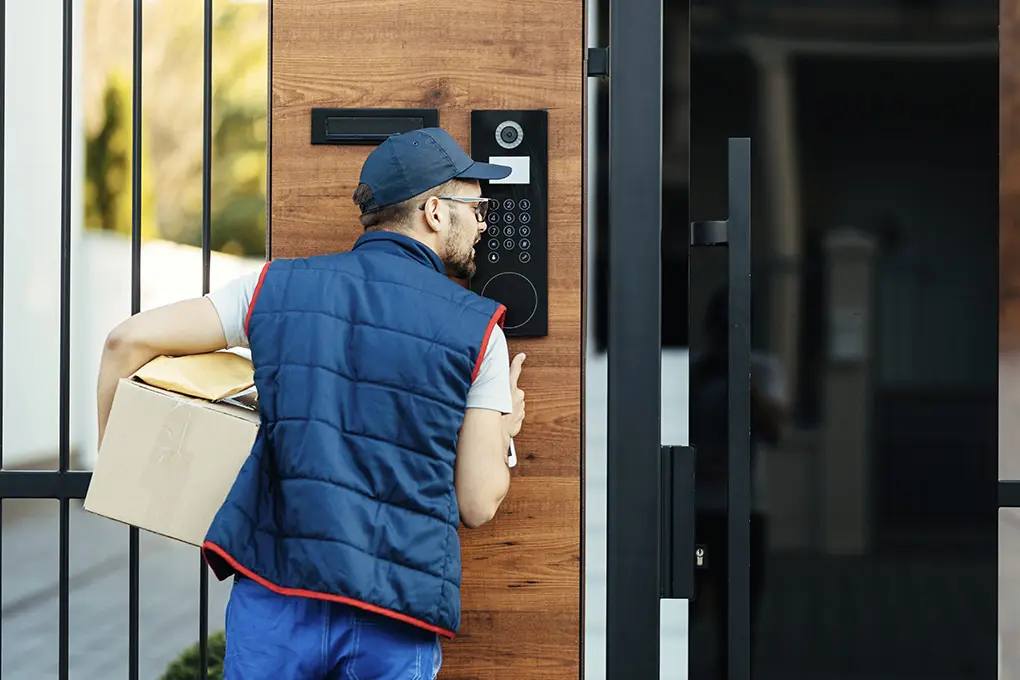When the sun goes down, your home becomes more vulnerable. Burglars often rely on the cover of darkness, and without strong outdoor security lighting, your property can look like an easy target.
FBI data from 2024 shows 166,478 residential burglaries happened at night. Pair that with the fact that property crimes occur every 25 seconds in the United States, and it’s clear that lighting isn’t just about visibility – it’s about prevention.
Research backs this up. A major study found that outdoor lighting can reduce crime by 39%, making it one of the most effective deterrents you can install. The right setup doesn’t just help your family safely navigate walkways after dark; it signals to intruders that your home is monitored, active, and off-limits.
The real challenge is choosing the right type of security lighting. Flood lights, motion-activated systems, and solar-powered options all bring unique benefits, from wide-angle coverage to energy efficiency and smart-home integration. By knowing these differences, you can create a lighting strategy tailored to your property that keeps your home safer every single night.
Table of Contents
- Key Takeaways
- Three Main Types of Outdoor Security Lighting
- Brightness Levels and Coverage: Matching Lumens to Security Needs
- Installation Considerations: Professional vs. DIY Approaches
- Comparing Costs: Initial Investment vs. Long-Term Savings
- Smart Features and Technology Integration
- Maintenance and Weather Durability
- Making the Right Choice for Your Home
- Final Thoughts on the Best Outdoor Security Lights
- Frequently Asked Questions
Key Takeaways
- Flood lights provide 1,000-3,000 lumens of continuous illumination, eliminating hiding spots and strongly deterring intruders.
- Motion-activated lights use PIR or dual sensors to detect heat changes, startling trespassers while saving energy through on-demand activation.
- Solar-powered systems now achieve over 20% panel efficiency and deliver 8-12 hours of operation per charge, making them ideal for remote or unwired areas.
- Brightness levels should match applications: 100-300 lumens for perimeters, 500-1,000 lumens for entry points, and up to 3,000 lumens for high-risk zones.
- Professional installation is recommended for hardwired systems, while solar and many motion lights allow DIY setup with careful placement.
- Smart features like app control, geofencing, and integrated cameras expand functionality and improve both convenience and security.
- Get started with Batten’s trusted recommendations for outdoor security lighting and smart home protection.
Three Main Types of Outdoor Security Lighting
Outdoor security lighting generally falls into three categories: traditional flood lights, motion-activated lights, and solar-powered lights. Each type offers distinct advantages and trade-offs, so understanding how they work will help you choose the right mix for your property.
1. Traditional Flood Lights: Constant Illumination for Maximum Coverage
Flood lights are the most straightforward option, providing continuous, wide-area illumination that leaves few places for intruders to hide. Most residential models produce between 1,000 and 3,000 lumens, bright enough to light up large yards, driveways, and entryways while also improving visibility for security cameras.
Why Flood Lights Work
The main strength of flood lights is their deterrent effect. Criminals prefer darkness, and a brightly lit home often causes them to move on to an easier target. When installed around key areas such as front doors, garage doors, and backyard access points, flood lights create a strong first line of defense.
Energy and Practical Considerations
Traditional halogen flood lights consume 50-150 watts, which can increase electricity bills and reduce bulb lifespan. In addition, some neighborhoods regulate outdoor brightness levels to prevent light pollution or disturbances to nearby homes.
Modern LED flood lights have solved many of these problems. Today’s LED versions cut energy consumption by up to 80% compared to halogen, while still producing a bright, consistent beam. They also last significantly longer, reducing replacement costs.
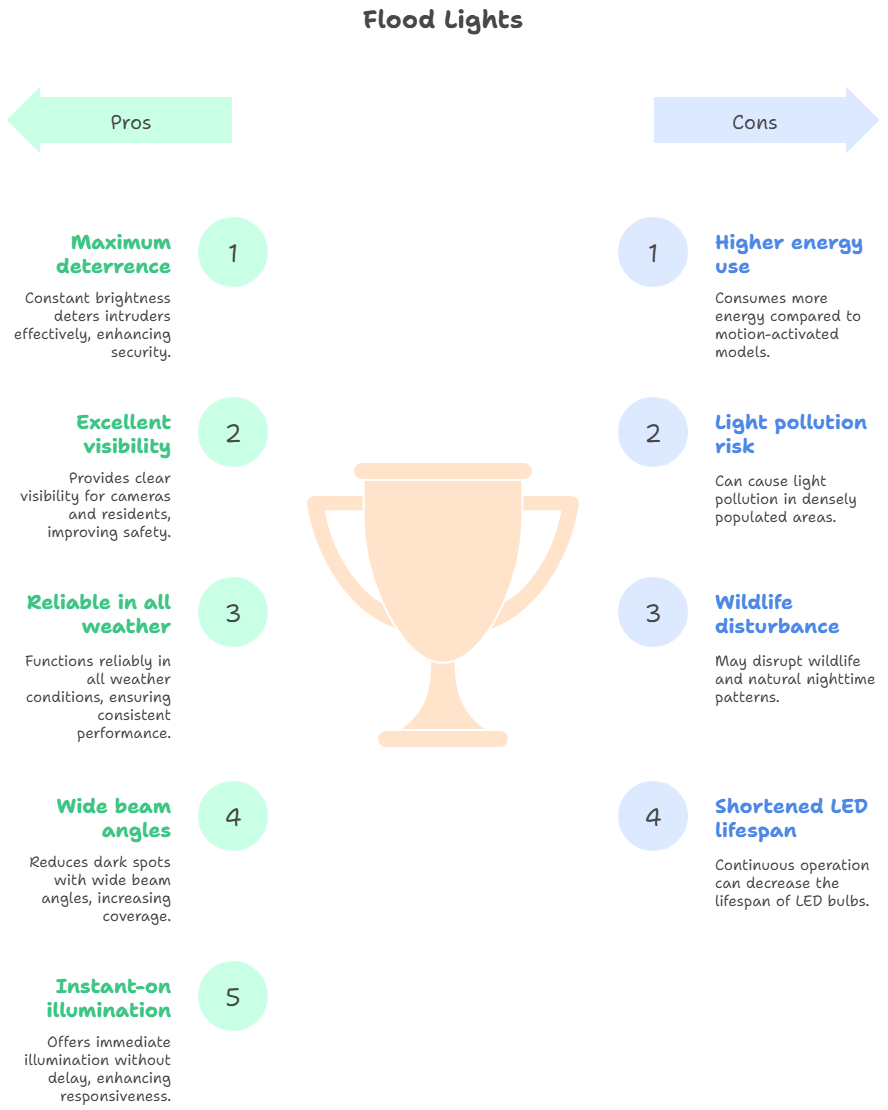
Flood Light Pros
- Maximum deterrence with constant brightness
- Excellent visibility for cameras and residents
- Reliable in all weather conditions
- Wide beam angles reduce dark spots
- Instant-on illumination with no delay
Flood Light Cons
- Higher energy use than motion-activated models
- Risk of light pollution in dense neighborhoods
- May disturb wildlife or natural nighttime patterns
- Continuous operation can shorten LED lifespan
2. Motion-Activated Lights: Smart Detection with Energy Efficiency
Motion-activated lighting combines detection technology with focused illumination, switching on only when movement is detected. This makes it highly energy-efficient while still delivering a strong deterrent effect.
How Motion Sensors Work
Most systems use passive infrared (PIR) sensors to detect heat changes, such as a person or animal moving across the sensor’s field of view. Coverage typically ranges from 20050 feet with angles between 120 and 180 degrees. More advanced models combine PIR with microwave sensors to reduce false alarms and improve accuracy.
Security Benefits
The sudden flash of light startles intruders and immediately alerts homeowners to activity. Unlike flood lights, which can fade into the background, the activation itself draws attention and creates psychological pressure on trespassers.
Smart Features and Setup
Many modern models include pet immunity settings to ignore smaller animals, along with daylight sensors that prevent activation during bright conditions. Premium units can integrate with home security systems, sending alerts to smartphones when triggered.
For best results, install motion lights 8-10 feet above the ground and angle sensors slightly downward. Avoid pointing them at heat sources like HVAC vents, which can cause false triggers. Overlapping coverage zones between multiple lights ensures that intruders cannot move undetected.
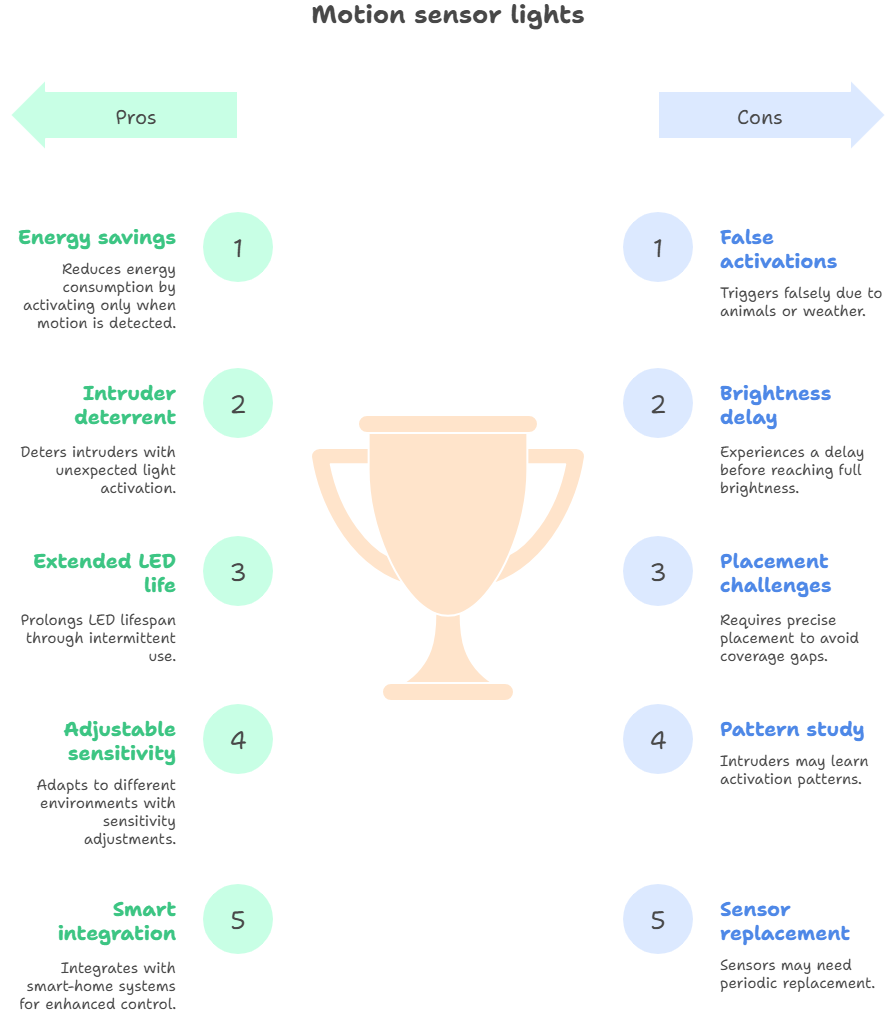
Motion Sensor Light Pros
- Energy savings from on-demand operation
- Strong surprise factor against intruders
- Extended LED lifespan due to intermittent use
- Sensitivity settings adjust to environment
- Smart-home and app integration options
Motion Sensor Light Cons
- Occasional false activations from animals or weather
- Brief delay between detection and full brightness
- Requires careful placement to avoid coverage gaps
- Intruders may study activation patterns
- Sensor components may require periodic replacement
3. Solar-Powered Security Lights: Off-Grid Convenience with Environmental Benefits
Solar-powered security lights have grown into a practical and cost-effective option thanks to improvements in photovoltaic technology and battery storage. These systems operate independently of your home’s wiring, making them ideal for areas where electrical lines are difficult or expensive to run.
How Solar Security Lights Operate
Solar panels absorb energy during the day and store it in rechargeable lithium-ion batteries. Quality models deliver 8-12 hours of illumination on a full charge, with some premium designs storing enough power for multiple cloudy days. Modern monocrystalline panels now achieve 20%+ efficiency, outperforming older polycrystalline designs.
Where Solar Lights Shine
Because they require no wiring, solar lights can be installed almost anywhere with sufficient sunlight. They are particularly effective for remote parts of your property, such as detached garages, sheds, fences, or garden perimeters. This flexibility allows you to cover areas often neglected by wired lighting.
Considerations for Performance
Placement is critical. Panels should face south (in the Northern Hemisphere) and remain free of shading from trees or buildings.
Choose models with IP65 or higher ratings for weather resistance, ensuring durability against rain, snow, and dust. Look for corrosion-resistant mounting hardware if your home is near the coast.
Battery maintenance is another consideration. Most lithium-ion packs last 3-5 years before needing replacement, and higher-capacity options are worth the investment if you live in areas with long winters or frequent storms.
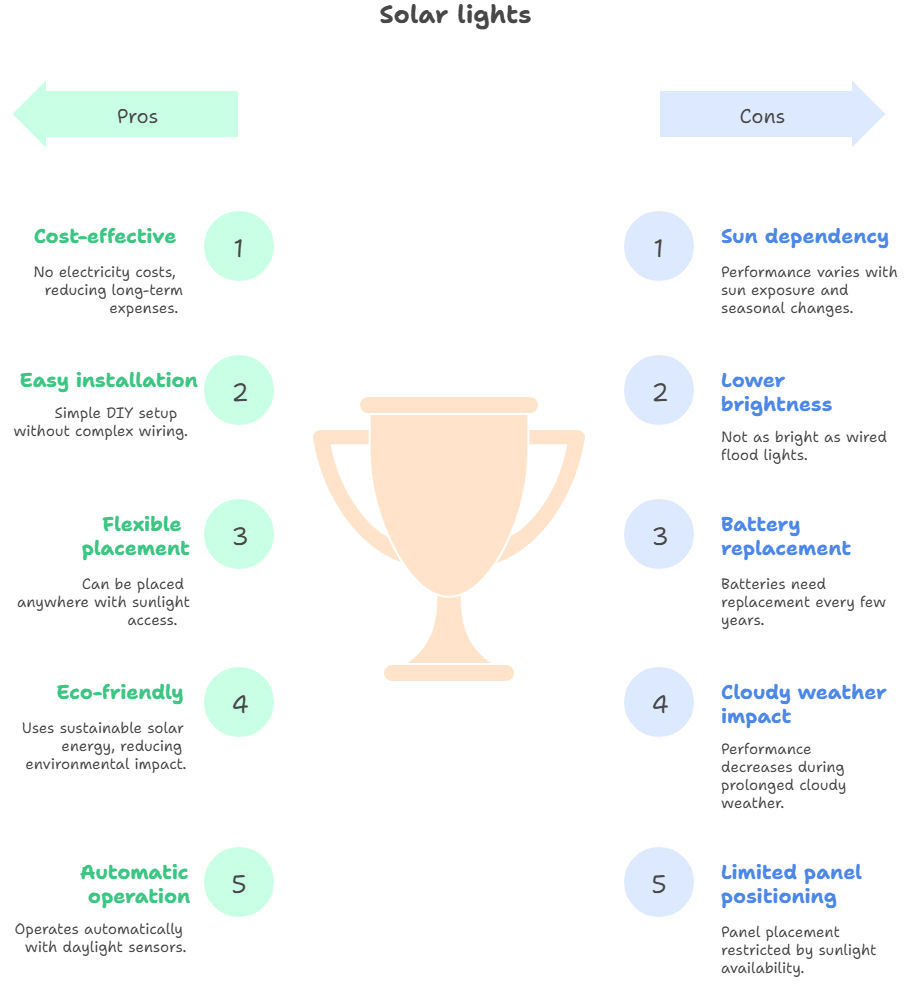
Solar Light Pros
- No ongoing electricity costs
- DIY-friendly installation with no wiring required
- Flexible placement across large properties
- Environmentally sustainable power source
- Automatic operation with daylight sensors
Solar Light Cons
- Dependent on sun exposure and seasonal conditions
- Lower brightness than wired flood lights
- Battery replacement needed every few years
- Weaker performance during extended cloudy weather
- Panel positioning limited by sunlight availability
Brightness Levels and Coverage: Matching Lumens to Security Needs
Getting the right brightness is critical for outdoor security lighting. Too little light creates blind spots, while too much can cause glare or disturb neighbors. Lumens measure the total light output, while foot-candles measure how much light actually reaches the ground or a surface. Both play a role in ensuring effective coverage.
General Security Lighting
For property perimeters, 100-300 lumens is usually enough to remove hiding spots without overwhelming surrounding homes. This level works well for fence lines, garden edges, or side yards where subtle but steady illumination discourages intruders.
Entry Points and High-Use Areas
Front doors, patios, and garage entrances need brighter lighting for visibility and security camera performance. Aim for 500-1,000 lumens to clearly identify visitors and ensure recorded footage captures accurate details. These lights should be mounted high enough to prevent tampering but angled to minimize glare on cameras.
High-Security Applications
Homes in high-crime neighborhoods or commercial properties often benefit from 1,500-3,000 lumens. At these levels, lighting creates near daylight conditions, which strongly deters intruders.
That said, careful positioning is essential to prevent light trespass into neighboring yards or onto public streets. Shielded fixtures and adjustable beam angles can help keep light directed where it is needed most.
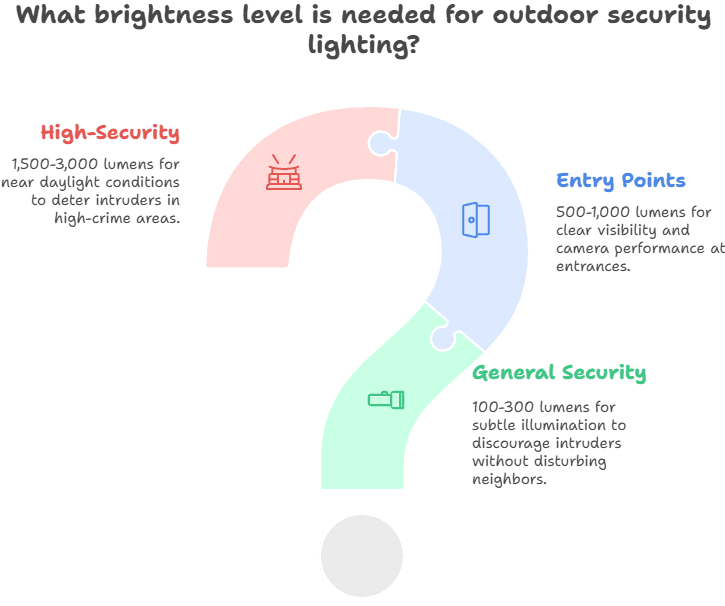
Layered Lighting Strategies
A layered approach balances safety, visibility, and comfort. Pathway lighting at 50-100 lumens improves navigation and reduces trip hazards. Medium-intensity area lighting of 300-800 lumens provides overall security coverage.
High-output spotlights at 1,000 lumens or more can then be reserved for critical zones like driveways, gates, or back entrances. Combining these levels ensures full coverage without wasted energy.
Color Temperature Considerations
Color temperature affects both visibility and comfort. Cool white light (5,000-6,500K) improves alertness and provides better color recognition, making it ideal for identifying faces and license plates.
Warm white light (2,700-3,500K) is softer and more welcoming, better suited for front porches or social areas where security and comfort must be balanced. A mix of both can improve overall effectiveness while maintaining a pleasant nighttime environment.
Installation Considerations: Professional vs. DIY Approaches
Once brightness levels are selected, the next step is deciding how the system will be installed. Some setups require professional expertise, while others can be handled by homeowners with basic tools.
Professional Installation Needs
Hardwired flood lights and motion sensors usually require permits and must follow electrical codes. This often makes professional installation the safest choice. Licensed electricians ensure proper wiring, adequate circuit capacity, and weatherproof connections. For larger systems or high-wattage lights, a dedicated circuit may be needed to prevent overloading existing electrical panels.
DIY-Friendly Options
Solar-powered lights are generally the easiest to install since they do not require electrical wiring. Homeowners only need basic tools for mounting. However, placement matters. Panels should be positioned for maximum sunlight, free from obstructions like trees or roof overhangs. Seasonal changes in sun angle should also be considered to maintain consistent charging.
Smart and Hybrid Systems
Smart security lighting integrates with Wi-Fi networks and home automation platforms. While the physical installation may be simple, setup often requires configuring apps, connecting to routers, and sometimes troubleshooting network compatibility. Hybrid solutions, such as light bulb security cameras for porch fixtures, offer a simple alternative for homeowners wanting both light and video monitoring without complex installation.
Automation and Timing Controls
Adding automation can make lighting more reliable and energy-efficient. Photocell sensors automatically switch lights on at dusk and off at dawn, ensuring coverage without manual input.
Programmable timers provide even more control, allowing homeowners to set custom on-off periods. Some advanced systems combine timers with smart-home features, letting residents control lighting schedules remotely from their phones.
Comparing Costs: Initial Investment vs. Long-Term Savings
Initial purchase prices vary significantly across lighting types, with basic motion sensors starting around $20-50, while premium solar floodlights can exceed $200-300. However, total cost of ownership includes installation, energy consumption, and maintenance expenses over the system’s lifespan.
Security Lighting Comparison Chart
The table below outlines the main differences between flood lights, motion sensor lights, and solar-powered security lights.
| Feature | Flood Lights | Motion Sensors | Solar Lights |
| Initial Cost | $30-150 | $20-120 | $40-300 |
| Installation | Professional required | DIY or Professional | DIY friendly |
| Energy Cost/Year | $15-80 | $5-25 | $0 |
| Coverage Area | 500-2,000 sq ft | 300-1,500 sq ft | 200-800 sq ft |
| Brightness Range | 800-3,000 lumens | 400-2,000 lumens | 100-1,500 lumens |
| Operating Hours | Continuous | On-demand | 8-12 hours |
| Weather Resistance | IP65+ | IP65+ | IP65+ |
| Lifespan | 15-25 years | 10-20 years | 3-5 years (battery) |
| Best For | High-security areas | Entry points | Remote locations |
| Maintenance | Low | Low | Medium |
Cost and Energy Efficiency
Solar lights eliminate ongoing electrical costs but require battery replacements every 3-5 years. Quality lithium-ion replacements generally range from $15 to $40, depending on capacity.
For flood and motion lights, modern LED technology has dramatically cut energy usage.
For example, a 15-watt LED flood light used 8 hours per day costs around $15-25 annually to operate, compared to $50-80 for halogen equivalents. Motion sensors offer additional savings by only activating when motion is detected.
Installation Considerations
Flood lights typically require professional installation because they must be hardwired into household circuits. This costs about $100-300 per fixture depending on labor rates and installation complexity.
Motion lights may be installed by homeowners with basic electrical knowledge, though professional setup ensures code compliance. Solar lights are the most DIY-friendly, requiring only mounting hardware and proper sun exposure.
Maintenance Needs
Flood and motion lights require minimal upkeep beyond occasional bulb replacements and cleaning. Solar lights, while cost-free to operate, need battery replacements every few years and occasional panel cleaning to maintain charging efficiency. Dust, pollen, or snow buildup can reduce performance, so wiping panels every few months ensures consistent operation.
Incentives and Insurance Benefits
Utility companies often provide rebates for installing energy-efficient outdoor lighting, covering 20-50% of the initial cost. LED fixtures and smart lighting systems commonly qualify for these programs.
Also, some insurance providers offer premium discounts for homes with comprehensive outdoor security lighting, recognizing the reduced likelihood of break-ins or vandalism. These savings can help offset installation and maintenance expenses over time.
Smart Features and Technology Integration
Smart technology allows homeowners to control, customize, and monitor lighting systems in ways that significantly strengthen both convenience and protection.
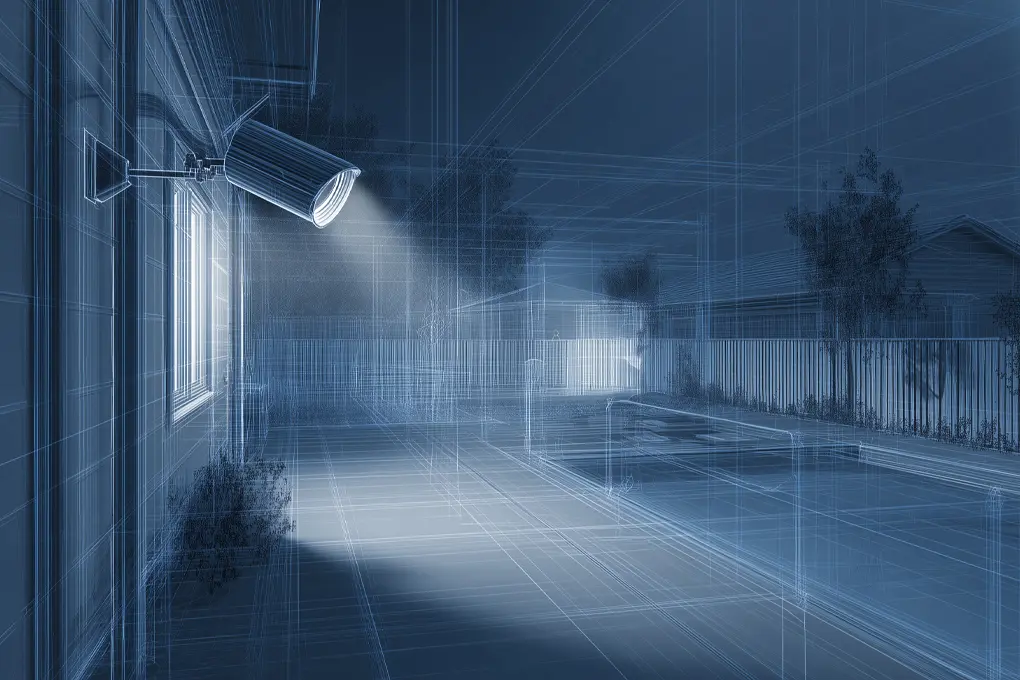
Smartphone Connectivity
Most modern security lights connect to Wi-Fi or Bluetooth, enabling control through dedicated smartphone apps. From the app, homeowners can switch lights on or off, adjust brightness, or schedule operating hours remotely. This feature is particularly valuable for vacation homes or when traveling, as lights can be turned on to give the appearance of occupancy.
Integrated Camera Systems
Combination units that merge lighting with video surveillance are becoming increasingly popular. For example, the Eufy Security Floodlight Cam E221 pairs powerful LED floodlights with high-definition video recording. These hybrid devices reduce installation costs compared to separate systems while providing both illumination and live monitoring in one package. Many include two-way audio and cloud storage options for added security.
Voice Assistant Control
Compatibility with platforms like Amazon Alexa, Google Assistant, or Apple HomeKit allows hands-free operation. Homeowners can issue commands such as “turn on the driveway lights” or set up routines where lights automatically activate if an alarm sensor trips. This seamless integration makes lighting part of a larger home automation network.
Customizable Settings
Smart lighting apps offer fine-tuned customization. Users can:
- Adjust sensor sensitivity to reduce false alarms.
- Change brightness levels depending on time of day.
- Create schedules that adapt to seasonal daylight changes.
- Set lighting scenes for security, entertaining, or pathway safety.
Some advanced systems use AI learning to adapt automatically to household routines, balancing energy efficiency with effective coverage.
Geofencing Capabilities
Geofencing uses smartphone GPS data to detect when residents are arriving or leaving. Lights can automatically switch on as a homeowner approaches and turn off once everyone leaves the property. This automation ensures consistent coverage without wasting energy.
Maintenance and Weather Durability
Because outdoor lights operate year-round in harsh environments, durability and upkeep are critical to performance. Choosing the right materials and performing simple maintenance can dramatically extend system lifespan.
LED Lifespan and Efficiency
LED bulbs last between 25,000 and 50,000 hours, compared to only 1,000-2,000 hours for incandescent bulbs. This extended lifespan reduces replacement frequency, which is especially important for lights mounted on high poles or hard-to-reach building exteriors. LEDs are also more energy-efficient, reducing operating costs over time.
Solar Panel Care
For solar-powered security lights, panel cleanliness is essential. Dust, pollen, or snow buildup can reduce charging efficiency by 20-30%. A quick rinse with water and a soft brush every few months restores output. In desert or high-pollen areas, more frequent cleaning may be required.
Weatherproof Ratings
Ingress Protection (IP) ratings indicate how well a fixture resists water and dust. IP65 ratings are sufficient for most residential installations, protecting against rain and dust intrusion. For areas prone to flooding or heavy storms, IP67 fixtures provide extra security by resisting temporary submersion in water.
Corrosion Resistance
Mounting hardware is often overlooked but critical for long-term safety. Stainless steel and aluminum hardware resist rust and corrosion, making them ideal for coastal or humid environments where salt air accelerates wear. Choosing corrosion-resistant materials prevents fixture sagging or failure over time.
Smart Diagnostics
Many newer lighting systems include built-in diagnostic alerts. These may appear as notifications in smartphone apps or as indicator lights on the fixture itself. Alerts can signal low battery levels, sensor malfunctions, or reduced performance, allowing quick action before the system fails.
Making the Right Choice for Your Home
Choosing the best outdoor security lighting depends on property size, neighborhood setting, climate conditions, and long-term budget considerations. By evaluating these factors, homeowners can build a system that balances effectiveness, efficiency, and comfort.

Property Size and Layout
Large properties with outbuildings or detached garages often need layered systems. Solar-powered lights are ideal for remote areas without easy wiring access, while hardwired flood lights provide strong coverage in high-traffic zones such as driveways or backyard entrances. Smaller urban properties may need fewer fixtures but require precise placement to avoid blind spots.
Urban, Suburban, and Rural Considerations
Urban homeowners typically favor motion-activated lights. These provide instant illumination without contributing to excessive brightness that might disturb neighbors or violate local light ordinances.
Suburban homes often benefit from flood lights, which offer broad coverage and a strong deterrent effect, particularly for homes with side yards and accessible fences. Rural properties, with fewer nearby light sources, can gain from a combination of solar units for remote perimeters and wired systems near the home.
Climate and Environmental Conditions
Climate directly affects solar lighting performance. Homes in sunny regions can rely more heavily on solar-powered fixtures, while shaded or northern climates may require hybrid systems that blend solar with hardwired or motion-activated lights. In coastal regions, it is important to choose fixtures with corrosion-resistant materials and IP65 or higher ratings to withstand salt air and heavy storms.
Budget-Friendly Strategies
For homeowners on a tighter budget, phased installation is a smart approach. Begin with the most critical areas such as front and back entrances, then gradually expand to side yards, pathways, and outbuildings. Starting small helps spread costs while still addressing the most vulnerable zones of the property. Some utility companies also offer rebates for energy-efficient LED security lighting, which can lower upfront costs.
Family and Safety Needs
Families with children often prioritize pathway lighting to make outdoor play or evening activities safer. Low-level fixtures along walkways or near patios improve visibility while reducing tripping hazards. Combining these with motion-activated or flood lights ensures the yard remains safe while also deterring potential threats.
Growing Into Smart Systems
Many homeowners find that starting with basic motion sensor systems provides immediate value. As comfort with security technology grows, it is easy to expand into smart systems with integrated cameras, app-based controls, and automation features. This gradual approach balances immediate needs with long-term upgrades.
Final Thoughts on the Best Outdoor Security Lights
Outdoor security lighting is one of the most effective ways to safeguard your home after dark. With burglaries occurring every 25 seconds in the United States and more than 166,000 happening at night in 2024, lighting is not just a convenience but a true deterrent.
Flood lights, motion-activated fixtures, and solar-powered systems each bring unique advantages, from continuous wide-area coverage to energy savings and flexible installation. The right solution depends on property layout, climate, budget, and family needs, but layered systems often deliver the strongest results.
By combining proper brightness levels, smart technology, and durable materials, homeowners can create a lighting strategy that discourages intruders, improves safety, and adds long-term value. Investing in quality lighting today gives peace of mind tomorrow, ensuring your property stays well protected.
Ready to illuminate your home’s security? Browse Batten’s expert-recommended home security tools – from smart cameras to comprehensive lighting systems – and start protecting what matters most with solutions designed for real-world safety.
Frequently Asked Questions
How Do I Choose the Right Brightness for My Security Lights?
The right brightness depends on location and purpose. Perimeter lighting generally requires 100-300 lumens to eliminate shadows, while entryways and garages benefit from 500-1,000 lumens for clear visibility. High-security areas may need 1,500-3,000 lumens. Balance brightness with positioning to avoid glare on neighbors’ properties and security cameras. Using shielded or directional fixtures helps ensure the light only covers areas you want to protect.
Can Outdoor Security Lighting Lower My Home Insurance Premiums?
Yes, many insurance companies recognize security lighting as a deterrent that reduces the likelihood of break-ins or vandalism. Discounts often range from 5-10% for homes with comprehensive lighting coverage, especially when combined with cameras or monitored alarm systems. It’s a good idea to check with your insurer, as some require proof of installation or system specifications before applying credits to your policy.
What Is the Best Placement for Motion-Activated Lights?
Motion-activated lights work best when mounted 8-10 feet above the ground and angled slightly downward. Place them near entry points, pathways, or dark corners where movement is likely. Avoid directing sensors toward HVAC vents or tree branches to reduce false triggers. Overlapping coverage zones between multiple lights prevents gaps, ensuring intruders cannot bypass detection by staying out of range.
How Long Do Solar Security Lights Last?
Most quality solar security lights last 3-5 years before requiring a battery replacement. LED bulbs themselves often last 25,000-50,000 hours, meaning the fixture can serve for many years with proper care. Regularly cleaning panels, checking for shading, and replacing batteries when output begins to weaken will extend their lifespan. Investing in models with lithium-ion batteries ensures better performance in temperature extremes.
Are LED Security Lights Better Than Halogen Models?
Yes, LED lights outperform halogen in nearly every category. They use up to 80% less energy, last 15-25 years compared to 1-2 years for halogen, and produce a brighter, more consistent beam. LEDs also generate less heat, which reduces wear on fixtures. While halogen lights may have lower upfront costs, LEDs are far more cost-effective over time, especially for continuous-use flood lighting.
What Additional Smart Features Should I Consider for Security Lighting?
Modern smart lights offer a variety of advanced features. Look for smartphone app control for remote access, geofencing to automatically activate lights when you arrive, and integration with home assistants like Alexa or Google Assistant. Some models include built-in cameras with two-way audio, motion sensitivity adjustments, and AI learning to adapt to household routines. These upgrades improve both convenience and overall home protection.
Sources
- CDE
- 10 Surprising Home Burglary Facts and Stats | SafeWise
- Outdoor Security Lights: An Overlooked Safety Measure
- FBI Releases 2024 Reported Crimes in the Nation Statistics — FBI
- Halogen vs. LED Flood Lights: Which to Choose
